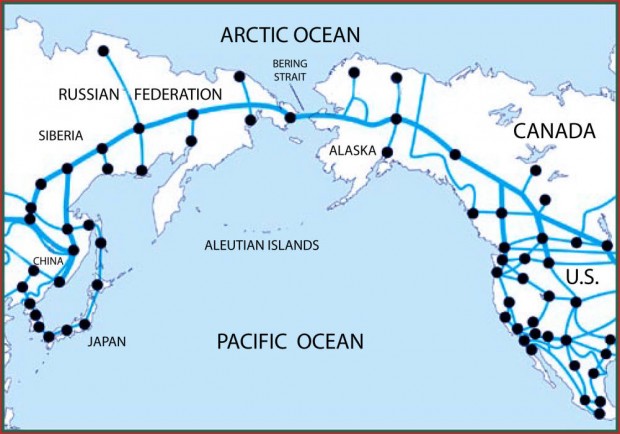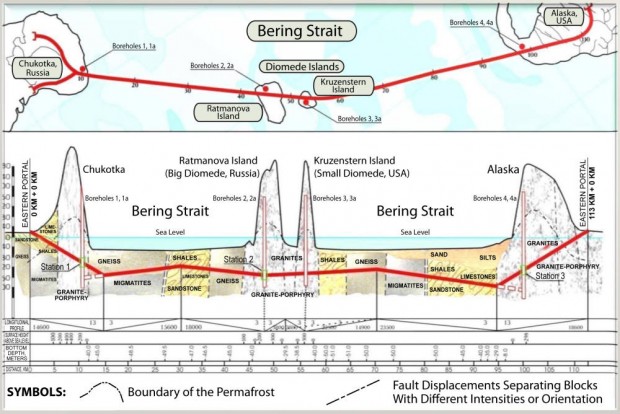April 28, 2012
Join Russia and USA by Rail Tunnels under the Bering Strait?

By rail, from New York to Moscow, and on to London! Only a 10,000 kilometer gap to fill in this bird's eye view of a trans Bering rail link. Map: Victor Razbegin
Russia’s Urals oil has been over $100 a barrel for a year now.
The country’s budgets are balanced. Debt is low. Savings are piling up. Russians are getting their pre-recession mojo back.
On the consumer end, sales of foreign cars made in Russia jumped 90 percent during the first quarter of 2012 over last year.
In the Kremlin, leaders are thinking big again.
In rapid succession, the government leaked a plan to create a “super agency” to develop the Russian Far East; President-elect Vladimir Putin vowed to spend $17 billion a year for new and improved railroads, and Vladimir Yakunin, president of Russian Railways, promoted a think big plan — a rail and tunnel link connecting Russia and the United States.
“It is not a dream,” Yakunin, a close ally of Mr. Putin, told reporters last week. “I am convinced that Russia needs the development of areas of the Far East, Kamchatka. I think that the decision to build must be made within the next three-five years.”
Next year, Russia’s railroad czar will open one big leg on the trip toward the Bering Strait – an 800 kilometer rail line to Yakutsk, capital of Sakha Republic, a mineral rich area larger than Argentina.
The country’s budgets are balanced. Debt is low. Savings are piling up. Russians are getting their pre-recession mojo back.
On the consumer end, sales of foreign cars made in Russia jumped 90 percent during the first quarter of 2012 over last year.
In the Kremlin, leaders are thinking big again.
In rapid succession, the government leaked a plan to create a “super agency” to develop the Russian Far East; President-elect Vladimir Putin vowed to spend $17 billion a year for new and improved railroads, and Vladimir Yakunin, president of Russian Railways, promoted a think big plan — a rail and tunnel link connecting Russia and the United States.
“It is not a dream,” Yakunin, a close ally of Mr. Putin, told reporters last week. “I am convinced that Russia needs the development of areas of the Far East, Kamchatka. I think that the decision to build must be made within the next three-five years.”
Next year, Russia’s railroad czar will open one big leg on the trip toward the Bering Strait – an 800 kilometer rail line to Yakutsk, capital of Sakha Republic, a mineral rich area larger than Argentina.

Moscow-born Fyodor Soloview lives in Anchorage, Alaska, where he lobbies for uniting his two homelands, Russia and the United States, with rail tunnels under the Bering Strait. Photo: Soloview
But the 270,000 residents of Yakutsk do not want to live at the dead end of a spur line. They dream of five kilometer long freight trains rolling past their city, carrying Chinese goods to North America, and North American coal and manufactured products to Russia and China.
From their city, 450 kilometers south of the Arctic Circle, passenger tickets could be sold west to London, and east to New York.
With the West’s swelling population of aging affluent retirees, what better gift for Mom and Dad than a one-month train trip, rolling across the International Dateline, traveling by rail three quarters of the way around the world? A TransBering rail voyage would make the TransSiberian and the TransCanada look like short hops.
To push thinking along, Yakutsk hosted a trans Bering rail conference last August. Engineers showed charts indicating that the tunnels under the Bering Strait would be 103 kilometers long, about twice the length of the tunnel under the English Channel. Unlike Europe’s “Chunnel,” there are two islands along the Bering route – geographical factors that would ease construction and allow for ventilation and emergency access.
To push thinking along, Yakutsk hosted a trans Bering rail conference last August. Engineers showed charts indicating that the tunnels under the Bering Strait would be 103 kilometers long, about twice the length of the tunnel under the English Channel. Unlike Europe’s “Chunnel,” there are two islands along the Bering route – geographical factors that would ease construction and allow for ventilation and emergency access.

For now, the only trains in Alaska run from Seward on the coast 760 kilometers into the interior, carrying tourists to Denali National Park and freight to two military bases. Photo: Fyodor Soloview
A trans Bering rail link was first seriously proposed by Czar Nicholas II in 1905. One century later, with the rise of China and the explosion of Asian manufacturing, some Russian economists believe that the day is near when a rail link to North America up would be economically viable.
The current price tag for the missing 10,000 kilometers, tunnel included: $100 billion. Freight fees are estimated at $11 billion a year.
Russian Railways estimates that a Bering Strait tunnel could eventually handle 3 percent of the world’s freight cargo. Yakunin says that China is interested in the project. At a railway meeting in Moscow Thursday, Mr. Putin said that freight traffic on a main Siberian line, the Baikal-Amur Mainline, is expected to nearly triple by 2020.
The current price tag for the missing 10,000 kilometers, tunnel included: $100 billion. Freight fees are estimated at $11 billion a year.
Russian Railways estimates that a Bering Strait tunnel could eventually handle 3 percent of the world’s freight cargo. Yakunin says that China is interested in the project. At a railway meeting in Moscow Thursday, Mr. Putin said that freight traffic on a main Siberian line, the Baikal-Amur Mainline, is expected to nearly triple by 2020.
To critics who worry about harsh winter weather, Russian Railways notes that since 1915, the company has been running passenger and freight trains year round to Murmansk, located 300 miles north of the Arctic Circle. The proposed route for a tunnel under the Bering Strait would pass 50 kilometers south of the Arctic Circle.

Trans Bering rail promoters envisage building feeder lines to connect 'stranded' mineral deposits and to allow shipment of freight between North American and Russia, China, Japan and the Korean peninsula. Map: InterBering
For a tunnel linking two continents, support has to be generated on the North American side. In Alaska, Fyodor Soloview, a native of Moscow, recently formed InterBering, a private group to lobby for rail construction to the Bering Strait.
“We can ship cargo between two the continents by rail,” Soloview said by telephone Thursday from his office in Anchorage. “Once the Bering tunnel is built, it will convert the entire world to different thinking.”
Yakunin estimates that the Russian side of a trans Bering railroad would take 10 to 15 years to build. That could fit into the political calendar of his friend Mr. Putin. On May 7, Mr. Putin will be inaugurated for a new six year term. He has left open the possibility of running in 2018 for another six year term.
So Russian Railways may have the political cover for another 12 years.
The question is whether oil prices will stay high enough to build a tunnel linking America and Asia.
If so, Washington’s diplomatic reset with Moscow could be welded in steel.
“We can ship cargo between two the continents by rail,” Soloview said by telephone Thursday from his office in Anchorage. “Once the Bering tunnel is built, it will convert the entire world to different thinking.”
Yakunin estimates that the Russian side of a trans Bering railroad would take 10 to 15 years to build. That could fit into the political calendar of his friend Mr. Putin. On May 7, Mr. Putin will be inaugurated for a new six year term. He has left open the possibility of running in 2018 for another six year term.
So Russian Railways may have the political cover for another 12 years.
The question is whether oil prices will stay high enough to build a tunnel linking America and Asia.
If so, Washington’s diplomatic reset with Moscow could be welded in steel.


But the tunnel is an expensive infrastructural object which can be fulfilled only together with the USA and Canada.
Now it sounds fantastically.
But when the first train will come to Anadyr` how it is shown on the map, the americans will start to think.
I agree.
At this point, the US does not seem to be in the mood to undertake big infrastructure projects. in the 2010s, we are not ready to take on a 1960s style Moon Project — however if Russia starts to meet the US halfway, this mood could change.
Jim
Moscow